I have a shelf-load of translated Manga:
Planet Ladder, by Yuri Harushima. (Tokyopop)
About a schoolgirl who finds strange supernatural things happening around her, and then finds herself dragged into a strange and dangerous magical world. Some think she’s really a princess from this magical realm. This is a rather shoujo-ish manga and the artwork is quite good. There is a rather nice cutie on the cover of vol.1
Bride of Demos, by Yuho Ashibe/Etsko Ikeda (ComicsOne)
Classic manga (1975), with shoujo-style artwork of the period. The heroine is beloved by a demon and finds that horrid things happen to anyone who gets emotionally close to her. Quite a good story. There was a short anime OVA inspired by the manga.
Hot Gimmick by Miki Aihara (Viz Shoujo)
The heroine gets herself in an embarrassing situation, mainly the fault of her promiscuous sister. As result she is open to blackmail by the son of the local factory and apartment block owner, who has recently returned to the area. As the boy used to be a nasty little bully, the omens are not good.
Full of teen angst and tense emotional situations – this is a popular series.
Miracle Girls by Nami Akimoto (Tokyopop)
Twin girls with quite different personalities have magical powers of telepathy and teleportation. A well-known old shoujo manga – also a TV anime. Rather dumb plot-lines.
Azumanga Daioh by Kiyohiko Azuma (ADV Manga).
The original 4- frame gag manga series, from which the popular TV anime was adapted. Featuring some schoolgirls, variously sporty, smart, or hyper-active, or just dim, all attending the same school, and their dysfunctional teachers. Excellent characterisations, and very funny. If it doesn’t make you laugh, seek professional help!
Basara by Yumi Tamura (VIZ shoujo)
The classic (1991) shoujo manga. Actually may be an acquired taste – the artwork is nice and it’s quite good describing characters, but, with its wonky future settings, to me gives a strong impression of having been written by a schoolgirl.
Shutterbox by Tavisha & Rikki Simons
This seems to be an American pseudo-manga. The heroine, though not dead, finds herself in the afterlife addending some sort of college. She’s a camera buff. This has nice artwork and is very funny; one of the best and most accessible of this batch of manga.
Figure 17 -Tsubasa & Hikaru, by Genco-olm & Guy Nakahira (ADV Manga)
Small girl moves to Hokkaido with her dad, who wants to become a specialist baker. An alien spacecraft which was carrying some captured nasties crashes nearby, and Tsubasa gets involved with the pilot who is trying to round up the escaped creatures. One of his alien tools accidentally clones Tsubasa into an identical girl/weapon, who enters Tsubasa’a life as Hikaru.
This is a striking mixture of a detailed account of rural life, mixed with sci-fi. There is also an anime, equally unusual in that it was made for TV with 50-minute episodes. Worth checking out.
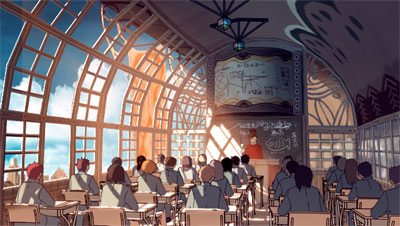 Classroom scene
Classroom scene
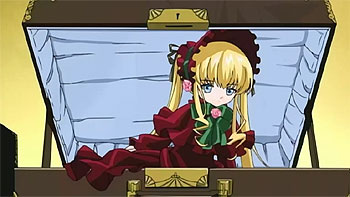 Shinku in her case
Shinku in her case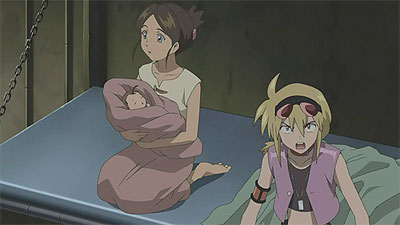 Isla and Ked
Isla and Ked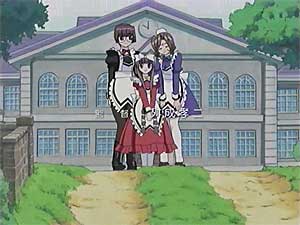 Kokoro is the youngest of three sisters who run the Kokoro Library founded by their father. The library is big enough to serve a city, but is situated in remote coutryside, and consequently is rarely visited. On Kokoro’s first day at the front desk, there is just one visitor, a young woman who borrows a book that she read as a child. A week later nobody at all turns up on the day appoined for this book’s return.
Kokoro is the youngest of three sisters who run the Kokoro Library founded by their father. The library is big enough to serve a city, but is situated in remote coutryside, and consequently is rarely visited. On Kokoro’s first day at the front desk, there is just one visitor, a young woman who borrows a book that she read as a child. A week later nobody at all turns up on the day appoined for this book’s return.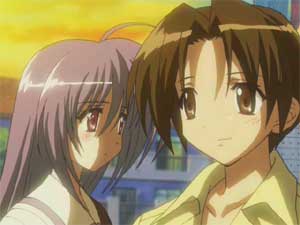
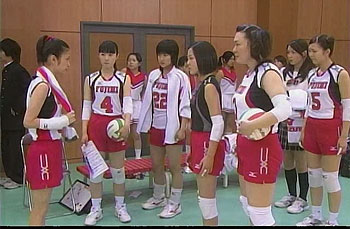
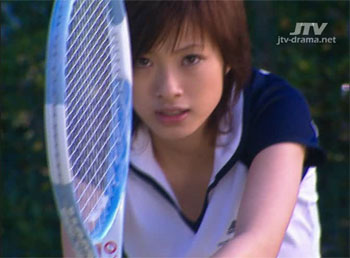 Hiromi on court. ep#2
Hiromi on court. ep#2